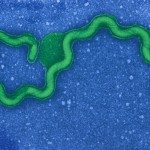Link to Pubmed [PMID] – 28260786
Nat. Rev. Microbiol. 2017 May;15(5):297-307
Pathogenic leptospires are the bacterial agents of leptospirosis, which is an emerging zoonotic disease that affects animals and humans worldwide. The success of leptospires as pathogens is explained by their spiral shape and endoflagellar motility (which enable these spirochetes to rapidly cross connective tissues and barriers), as well as by their ability to escape or hijack the host immune system. However, the basic biology and virulence factors of leptospires remain poorly characterized. In this Review, we discuss the recent advances in our understanding of the epidemiology, taxonomy, genomics and the molecular basis of virulence in leptospires, and how these properties contribute to the mechanism of pathogenesis of leptospirosis.

